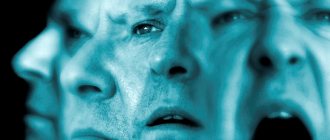One of the most mysterious and diverse mental disorders is schizophrenia. This is a disease with numerous symptoms expressed to varying degrees and various course options. Depending on the symptoms, psychiatrists distinguish several types of this disease.
One of them is known as paranoid schizophrenia (more correctly paranoid), which entails emotional and behavioral disturbances. The disease is distinguished by the dominance of hallucinations and delusions, catatonic symptoms, and affective flattening. As a rule, the disease begins late - at the age of 25-35, and is characterized by hostility, irritability, suspicion, intolerance, and tension.
What is paranoid schizophrenia
Paranoid schizophrenia is the most common type of illness. Sometimes mistakenly called paranoid schizophrenia. It is manifested by the presence of delusions of persecution, obsessions, conversations with non-existent interlocutors, and problems with self-identification are observed. Sometimes paranoid schizophrenia is accompanied by hallucinations and catatonic symptoms (in a mild form).
The exact causes of the disease have not yet been fully determined. Possible reasons that can provoke hereditary mental disorders are: the influence of the environment, family upbringing, prenatal and stress factors, alcoholism, drug addiction and disorders in the brain (neurobiological factors), age crisis.
Prevention of paranoid (paranoid) schizophrenia
Schizophrenia affects about 10% of the population. The first, pronounced attack often occurs before the age of 30. But early signs and symptoms of paranoid (paranoid) schizophrenia can occur as early as adolescence and young adulthood. Anyone can develop schizophrenia during their lifetime. As the disease progresses, social aspects of life and a person’s functioning in society suffer, which causes the person severe mental discomfort.
Statistics, risk group
Schizophrenia is an endogenous pathology that ranks first among psychoses in terms of prevalence, progression and severity of consequences in the social sphere of the individual.
In recent years, there has been an increase in the number of young patients. The paranoid form of the disease is the most common variant. Over the course of 1 year, 560,000–600,000 patients suffering from schizophrenia are registered in Russia. Of the indicated number, 85-87% of patients have a paranoid form. People with a genetic predisposition to psychosis are at risk. The paranoid form most often occurs in people aged 25 to 35 years. Delusional and hallucinatory disorders predominate.
Men are affected more often than women. Statistics indicate the following. 100% of patients experience severe behavioral disturbances. Negative symptoms were present in 96% of those studied, delirium in 93%. Chronic paranoid symptoms are diagnosed less frequently - in 67% of patients. Verbal hallucinations are characteristic of 59% of patients. Men are more likely to have persistent delusions (men - in 98% of cases, women - in 87%). Catatonic behavior is characteristic of men (in 13% of cases, and in women - in 2% of cases).
Paranoid schizophrenia diagnosis
At the Transfiguration Clinic Center for Psychiatry and Psychotherapy, clients will receive comprehensive medical care:
- diagnosis and detection of mental development disorders;
- determining the risk of schizophrenia;
- identifying symptoms of the disease;
- selection and prescription of optimal methods of recovery and treatment;
- determining the effectiveness of treatment;
- application of methods to prevent relapses of schizophrenia;
- the use of rehabilitation methods to return a person to a full life.
Signs and symptoms of paranoid schizophrenia
The main symptom of paranoid schizophrenia is delusion. These are persistent illogical attitudes that lead to an incorrect understanding of the world. With this mental pathology, delirium is of a mixed nature. This is also a feeling of persecution, when the patient seems to be involved in some matter for which he may be punished. Delirium of high origin: a person appropriates non-existent regalia to himself. Hypochondriacal delusions in paranoid schizophrenia are fanciful and have little connection with reality. For example, a patient claims that computers were implanted inside his body, which disrupt the functioning of his organs. In addition, delusions of love, jealousy, dysmorphophobia (non-existent physical defect) and others may occur. As the disease progresses, delirium is built into a clear, systematic chain.
Paranoid schizophrenia and delusions
Delusional disorders may be accompanied by hallucinations. This is a distortion of perception when a person perceives something that is not in the real world. The most common are auditory hallucinations: voices that only the person himself hears. They criticize the patient, argue with each other, and are threatening, forcing the person to do what he does not want. If visual hallucinations occur, the patient becomes even more disconnected from reality.
Other mental disorders in paranoid schizophrenia include:
- senestopathy - painful bodily sensations that have no physical basis;
- depersonalization – a disorder of self-perception, with alienation of one’s personality;
- social isolation and withdrawal into one’s inner world;
- emotional inadequacy, anxiety, sleep disturbances and other general mental disorders.
In paranoid schizophrenia, thinking remains intact for a long time. Negative symptoms also develop to a small extent: the will rarely suffers and emotional devastation is practically not expressed. Therefore, this group of patients maintains working capacity and commitment to socially approved actions for a long time: creating a family, having children, and others.
Most often, schizophrenia begins with auditory hallucinations, which are subsequently supplemented by visual ones. Delusion is characterized by a distorted reflection of the surrounding world, which becomes the reason for incorrect understanding of situations and a source for the development of false judgments and assessments.
Signs of delusion and hallucinations
The following behavioral factors may indicate the presence of auditory or visual hallucinations:
- a person talks to himself in the form of a conversation or remarks;
- at the moment when the patient becomes silent, those around him get the impression that he is listening to something. At the same time, the impression arises that he sees and hears what others do not see;
- causeless, hysterical laughter or, conversely, anxiety and concern may occur;
- During a conversation, it is difficult for the patient to concentrate on one topic.
The following signs indicate the presence of delirium:
- the individual’s attitude towards others changes sharply, unjustified hostility or isolation, alienation appears;
- statements become dubious, implausible, meaningful, and incomprehensible to others;
- a person begins to fear for his life or for the lives of loved ones; fear and anxiety are clearly manifested, which can be expressed in constantly locking doors, curtaining windows, checking food for the presence of poisons, etc.
It is necessary to react to the above behavior of the patient with the utmost restraint and delicacy. It is strictly forbidden to mock, argue with him, discuss his hallucinations, or detail them. The main thing in such a situation is to help the person feel protected, to inspire trust, and to carefully persuade them to see a doctor for advice. Relatives need to be especially vigilant towards a patient whose suicidal tendencies have worsened during the course of the disease.
Differential diagnosis
To correctly diagnose paranoid schizophrenia, it is necessary to exclude the possibility of developing delusional disorder, acute transient psychotic and schizoaffective disorders, dementia and other organic personality disorders.
Case history of a famous scientist
In 1958, at the age of 30, the famous mathematician John Nash showed the first signs of the disease and was diagnosed with paranoid schizophrenia. During this same period of his life, Nash made several discoveries in the field of mathematics. During his life, he was treated in psychiatric clinics several times. When the mathematician's health improved at age 34, he got a job at Princeton University.
At the age of 66, John Nash received the Nobel Prize in Economics. Thanks to John Nash's research, a new scientific approach emerged in mathematics.
The scientist learned to live with a diagnosis of paranoid schizophrenia. And this did not stop him from achieving success. His life story became the basis for the film A Beautiful Mind.
How to overcome schizophrenia?
Treatment of schizophrenia involves the use of a whole range of methods: drug treatment, psychological support, psychotherapy and social rehabilitation.
Treatment of paranoid schizophrenia
The first attack may mark the beginning of a long-term mental illness, or it may never occur again. The success of treatment largely depends on the time of detection of the disease: the earlier signs of schizophrenia are identified, the sooner treatment begins, the greater the likelihood of a positive prognosis and the higher the chances of long-term remission.
Paranoid schizophrenia is completely curable with modern means!
Anyone who wants to recover and receives the support of loved ones and caring people has every chance of curing their mental illness. According to general statistics, every fifth person in the world who suffers from schizophrenia, with the right approach to treatment, achieves long-term remission of 5 years or more. These people become full-fledged members of society and a reliable support in their family.
Research shows that if a patient participates in a special psychotherapy program, the patient’s likelihood of long-term remission increases sharply.
Treatment of paranoid schizophrenia is carried out under the supervision of a psychiatrist using medications (antipsychotics), psychotherapeutic methods under the guidance of a psychotherapist and a clinical psychologist. During treatment, the client undergoes a mandatory course of rehabilitation in the hospital and after discharge.
Prognosis in the treatment of paranoid schizophrenia
In our clinic, 90% of patients achieve a high degree of remission and can live and work on minimal doses of maintenance medications. Even when taking medications for a long time, patients can lead a normal life and realize their full potential. This requires a rehabilitation course in which the patient and his relatives participate. As statistics show, very often people who have suffered an illness can return to a busy life and become even more productive than the average person.
Forecasts
Regardless of the type of schizophrenia, it is classified as an incurable mental pathology. The prognosis of the disease is particularly influenced by the timeliness of the start of treatment, its intensity and combination with social rehabilitation measures.
According to research by practicing psychotherapists, patients who sought help in a timely manner and followed all the instructions and recommendations of doctors experienced stable remission followed by complete social rehabilitation.
Do not despair if you or one of your family and friends has been diagnosed with paranoid schizophrenia. In modern psychiatry, innovative methods are used to treat mental pathologies. Timely, competent diagnosis, unquestioning compliance with all the requirements of the attending physician, support from loved ones provide a chance to minimize the negative consequences of the disease and normalize the quality of life.
Paranoid schizophrenia being treated in a clinic
At the Moscow center of psychiatry and psychotherapy “Preobrazhenie Clinic” you will receive everything you need for complete treatment of paranoid schizophrenia. The clinic’s specialists provide comprehensive treatment using the most effective methods. Both patients and loved ones receive assistance. You can find out the cost of services here.
Why should paranoid schizophrenia be treated?
The specialists of our clinic are attentive to each patient and are ready to help you in the fight against mental illness. Here you will receive all the necessary medical and psychological assistance, the patient will be prescribed medication and supportive psychotherapy. “Transfiguration Clinic” works so that you and your loved ones can return to a full life and forget about mental illness.
With us you will receive:
- rapid treatment with accurate diagnosis;
- attentiveness and understanding;
- psychological support for the patient’s loved ones;
- a full range of services for the rehabilitation of a patient with schizophrenia;
- anonymity of treatment and compliance with confidentiality conditions.
Specialists at the Transfiguration Clinic of psychiatry and psychotherapy in Moscow are ready to help your loved one and you at any time.
Causes
Among the main reasons that can provoke the appearance of the paranoid type of schizophrenia are the following:
- genetic predisposition. The risk of developing the disease increases in individuals in whose family there have been recorded cases of mental disorders;
- physiological disorders of the central nervous system and brain;
- regular stressful situations, prolonged mental and psychological stress, leading to exhaustion of the human nervous system.
The paranoid form of mental illness is chronic or episodic in nature, which is accompanied by primary symptoms of the disease.
Schizophrenics, regardless of the form of the disease, are strictly prohibited from consuming alcoholic beverages, narcotic and psychotropic drugs, which can lead to changes in consciousness.
Paranoid syndrome
Paranoid syndrome is the next stage of paranoid schizophrenia, which is characterized by the presence of a mild form of systematic delusions. This means that the patient can interpret and explain it well. Typical crazy ideas:
- Reformative - the patient is convinced that he has invented or created something brilliant that can change the structure of the world.
- Erotic - the conviction of the existence of a maniac who constantly pursues.
- Belief in one’s own chosenness, high origin, in belonging to the royal family or representatives of “blue blood”.
- Kverulyantskie - constant slander, filing complaints and incessantly fighting for their rights.
In paranoid syndrome, delusions are structured and systematized. The patient can logically justify arguments and provide evidence of his theories. He is not tormented by hallucinations or automatisms, so he does not consider himself sick. This aggravates the situation, since he will be met with misunderstanding from people. This will lead to depression and further development of the disease.
Stages of accepting a delusional thought:
- Expectation is an internal anxiety, a feeling that something incredible is about to happen.
- Insight - suddenly a person understands where his fear comes from, he begins to see everything differently, looks at the world with “new eyes.”
- Systematization - everything fits into one picture, which the patient can rationally explain and describe.
If the disease is detected at this stage, a diagnosis of paranoid schizophrenia will be made.











